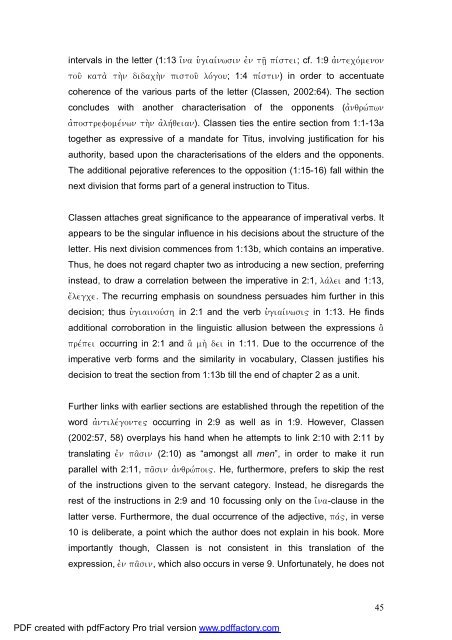A Text centred rhetorical analysis of Paul's Letter to Titus
A Text centred rhetorical analysis of Paul's Letter to Titus
A Text centred rhetorical analysis of Paul's Letter to Titus
You also want an ePaper? Increase the reach of your titles
YUMPU automatically turns print PDFs into web optimized ePapers that Google loves.
intervals in the letter (1:13 i{na uJgiaivnwsin ejn th`/ pivstei; cf. 1:9 ajntecovmenon<br />
<strong>to</strong>u` kata; th;n didach;n pis<strong>to</strong>u` lovgou; 1:4 pivstin) in order <strong>to</strong> accentuate<br />
coherence <strong>of</strong> the various parts <strong>of</strong> the letter (Classen, 2002:64). The section<br />
concludes with another characterisation <strong>of</strong> the opponents (ajnqrwvpwn<br />
ajpostrefomevnwn th;n ajlhvqeian). Classen ties the entire section from 1:1-13a<br />
<strong>to</strong>gether as expressive <strong>of</strong> a mandate for <strong>Titus</strong>, involving justification for his<br />
authority, based upon the characterisations <strong>of</strong> the elders and the opponents.<br />
The additional pejorative references <strong>to</strong> the opposition (1:15-16) fall within the<br />
next division that forms part <strong>of</strong> a general instruction <strong>to</strong> <strong>Titus</strong>.<br />
Classen attaches great significance <strong>to</strong> the appearance <strong>of</strong> imperatival verbs. It<br />
appears <strong>to</strong> be the singular influence in his decisions about the structure <strong>of</strong> the<br />
letter. His next division commences from 1:13b, which contains an imperative.<br />
Thus, he does not regard chapter two as introducing a new section, preferring<br />
instead, <strong>to</strong> draw a correlation between the imperative in 2:1, lavlei and 1:13,<br />
e[legce. The recurring emphasis on soundness persuades him further in this<br />
decision; thus uJgiainouvsh in 2:1 and the verb uJgiaivnwsi" in 1:13. He finds<br />
additional corroboration in the linguistic allusion between the expressions a}<br />
prevpei occurring in 2:1 and a} mh; dei in 1:11. Due <strong>to</strong> the occurrence <strong>of</strong> the<br />
imperative verb forms and the similarity in vocabulary, Classen justifies his<br />
decision <strong>to</strong> treat the section from 1:13b till the end <strong>of</strong> chapter 2 as a unit.<br />
Further links with earlier sections are established through the repetition <strong>of</strong> the<br />
word ajntilevgonte" occurring in 2:9 as well as in 1:9. However, Classen<br />
(2002:57, 58) overplays his hand when he attempts <strong>to</strong> link 2:10 with 2:11 by<br />
translating ejn pa`sin (2:10) as “amongst all men”, in order <strong>to</strong> make it run<br />
parallel with 2:11, pa`sin ajnqrwvpoi". He, furthermore, prefers <strong>to</strong> skip the rest<br />
<strong>of</strong> the instructions given <strong>to</strong> the servant category. Instead, he disregards the<br />
rest <strong>of</strong> the instructions in 2:9 and 10 focussing only on the i{na-clause in the<br />
latter verse. Furthermore, the dual occurrence <strong>of</strong> the adjective, pav~, in verse<br />
10 is deliberate, a point which the author does not explain in his book. More<br />
importantly though, Classen is not consistent in this translation <strong>of</strong> the<br />
expression, ejn pa`sin, which also occurs in verse 9. Unfortunately, he does not<br />
PDF created with pdfFac<strong>to</strong>ry Pro trial version www.pdffac<strong>to</strong>ry.com<br />
45

















